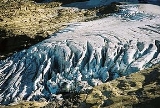
Jackson Glacier
Encyclopedia
Jackson Glacier is approximately the seventh largest of the remaining 25 glaciers in Glacier National Park located in the U.S. state
of Montana
. A part of the largest grouping of glaciers in the park, Jackson Glacier rests on the north side of Mount Jackson
. The glacier was most recently measured in 2005 at 250 acres (1 km²), yet when first documented in 1850, the glacier also included the now separate Blackfoot Glacier
and together, they covered 1875 acres (7.6 km²). Between 1966 and 2005, Jackson Glacier lost almost a third of its acreage. When the two glaciers were united prior to their separation sometime before 1929, they were known simply as Blackfoot Glacier. In 1850, there were an estimated 150 glaciers in the park. Glaciologists have stated that by the year 2030, many if not all of the glaciers in the park may disappear completely. Jackson and Blackfoot glaciers have been selected for monitoring by the U.S. Geological Survey's Glacier Monitoring Research program, which is researching changes to the mass balance
In 1850, there were an estimated 150 glaciers in the park. Glaciologists have stated that by the year 2030, many if not all of the glaciers in the park may disappear completely. Jackson and Blackfoot glaciers have been selected for monitoring by the U.S. Geological Survey's Glacier Monitoring Research program, which is researching changes to the mass balance
of glaciers in and surrounding Glacier National Park. The glacier is being monitored using remote sensing equipment and repeat photography, where images of the glacier are taken from identical locations periodically. Jackson Glacier is one of the easiest of the park's glaciers to observe, and is located south of the Going-to-the-Sun Road
on the east side of the Continental Divide
, upper St. Mary Valley.

U.S. state
A U.S. state is any one of the 50 federated states of the United States of America that share sovereignty with the federal government. Because of this shared sovereignty, an American is a citizen both of the federal entity and of his or her state of domicile. Four states use the official title of...
of Montana
Montana
Montana is a state in the Western United States. The western third of Montana contains numerous mountain ranges. Smaller, "island ranges" are found in the central third of the state, for a total of 77 named ranges of the Rocky Mountains. This geographical fact is reflected in the state's name,...
. A part of the largest grouping of glaciers in the park, Jackson Glacier rests on the north side of Mount Jackson
Mount Jackson (Montana)
Mount Jackson is located in the Lewis Range, Glacier National Park in the U.S. state of Montana. Mount Jackson is the fourth tallest mountain in Glacier National Park and it is situated on the Continental Divide. Both the mountain and its namesake Jackson Glacier are easily seen from the...
. The glacier was most recently measured in 2005 at 250 acres (1 km²), yet when first documented in 1850, the glacier also included the now separate Blackfoot Glacier
Blackfoot Glacier
-See also:* List of glaciers in the United States* Glaciers in Glacier National Park...
and together, they covered 1875 acres (7.6 km²). Between 1966 and 2005, Jackson Glacier lost almost a third of its acreage. When the two glaciers were united prior to their separation sometime before 1929, they were known simply as Blackfoot Glacier.

Glacier mass balance
Crucial to the survival of a glacier is its mass balance, the difference between accumulation and ablation . Climate change may cause variations in both temperature and snowfall, causing changes in mass balance. Changes in mass balance control a glacier's long term behavior and is the most...
of glaciers in and surrounding Glacier National Park. The glacier is being monitored using remote sensing equipment and repeat photography, where images of the glacier are taken from identical locations periodically. Jackson Glacier is one of the easiest of the park's glaciers to observe, and is located south of the Going-to-the-Sun Road
Going-to-the-Sun Road
Going-to-the-Sun Road is the only road through the heart of Glacier National Park in Montana, USA. It was completed in 1932, and it is the only road that crosses the park, going over the Continental Divide at Logan Pass. A fleet of 1930s red tour buses "jammers", rebuilt in 2001 to run on propane...
on the east side of the Continental Divide
Continental Divide
The Continental Divide of the Americas, or merely the Continental Gulf of Division or Great Divide, is the name given to the principal, and largely mountainous, hydrological divide of the Americas that separates the watersheds that drain into the Pacific Ocean from those river systems that drain...
, upper St. Mary Valley.

See also
- List of glaciers in the United States
- Glaciers in Glacier National Park (U.S.)Glaciers in Glacier National Park (U.S.)There are at least 35 named glaciers in Glacier National Park . In 1850, Glacier had 150 glaciers. There are 25 active glaciers remaining in the park today. Since the ice ages stopped 10,000 years ago, there have been many slight climate shifts causing periods of glacier growth or melt-back...

